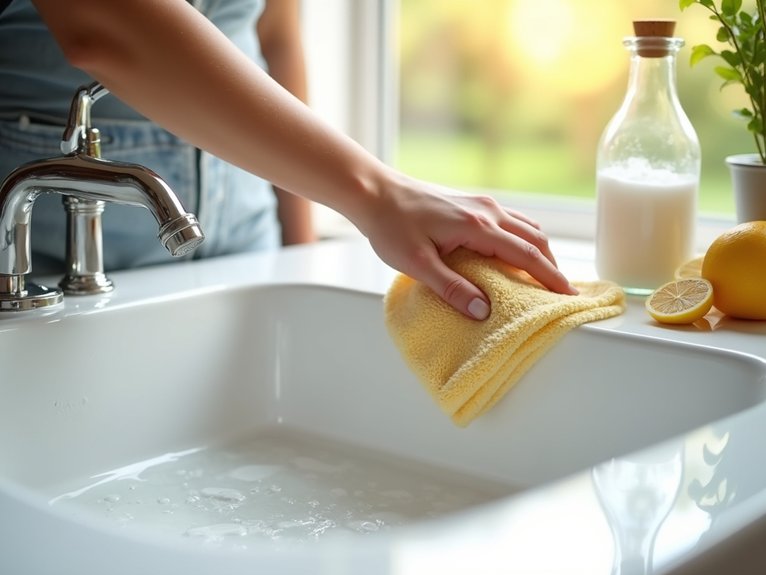Norėdami greitai išvalyti kriauklę be chemikalų, išimkite iš apačios esančius daiktus, atsargiai išardykite nutekamojo vamzdžio sudedamąsias dalis, pvz. Naudokite vandens žarną su siauru antgaliu, kad pašalintumėte nešvarumus, šiukšles ir susikaupusias nuosėdas iš vamzdžių vidaus. Šveiskite dantų šepetėliu, tada iš naujo sumontuokite nutekėjimo mechanizmą, užtikrindami sandarias jungtis ir sklandų veikimą. Tolesni žingsniai atskleis kruopštų požiūrį į kriauklės priežiūrą ir higieną.
Kriauklės paruošimas: Išvalykite denius
Kaip paruošti dirvą kruopščiam kriauklių valymui? Pirmasis svarbus žingsnis – sukurti laisvą darbo erdvę pašalinant visus po kriaukle laikomus daiktus. Taip bus galima netrukdomai prieiti ir išvengti galimos vandens žalos ar sandėliuojamų daiktų užteršimo valymo proceso metu.
Po kriaukle strategiškai patogiai pastatykite didelę plastikinę vonią. Ši apsaugos priemonė sulaikys vandenį, šiukšles ar biologines plėveles, kurios gali išsilieti per išmontavimo ir valymo etapus. Metodiškai paruošus darbo vietą, vėlesnė plautuvės priežiūra tampa veiksmingesnė ir labiau kontroliuojama.
Išardykite drenažo sudedamąsias dalis
Išvalius po kriaukle esančią darbo erdvę, kitas žingsnis – sistemingai išardyti nutekėjimo komponentus, kad būtų galima kruopščiai išvalyti.
Namų savininkas atsargiai atsuka U formos vamzdį, jį nuima, kad ištuštintų susikaupusį vandenį ir apžiūrėtų, ar nėra šiukšlių. Tada iš kriauklės nutekamojo vamzdžio išstumiamas galinis vamzdis, kad būtų galima prieiti prie vidinių paviršių. Dantų šepetėlis tampa labai svarbiu įrankiu šalinant biologinę plėvelę ir susikaupusias nuosėdas iš vamzdžio vidaus.
Iššokantį mazgą reikia atjungti atsukant pasukamąją veržlę, taip atskiriant kamščio mechanizmą. Kruopščiai nuėmus kiekvieną komponentą, galima jį visiškai išvalyti ir atkurti idealų drenažo veikimą.
Išvalykite ir pašalinkite susikaupusias nuosėdas
Vandens žarna tampa galingu valymo įrankiu, kuriuo galima pašalinti susikaupusį purvą ir šiukšles iš kriauklės nutekėjimo komponentų. Naudodami siaurą antgalį, namų savininkai gali pašalinti susikaupusius plaukus, riebalus, muilo likučius ir dantų pastą iš kriauklės išleidimo angos ir nuotekų sifono.
Aukšto slėgio srovė veiksmingai išvalo vidinius paviršius, todėl jie tampa švarūs ir blizgantys. Šis cheminių medžiagų nenaudojantis metodas ne tik pašalina galimus užsikimšimus, bet ir atkuria idealias drenažo savybes.
Šis metodas vienodai veiksmingas virtuvės kriauklėms, vonioms ir dušo nutekamiesiems vamzdžiams – tai paprastas ir veiksmingas sprendimas, padedantis palaikyti santechnikos higieną ir funkcionalumą.
Surinkite kriauklės mechanizmą iš naujo
Norint iš naujo sujungti kriauklės komponentus, reikia kruopštaus tikslumo ir sistemingo surinkimo. Užpakalinės dalies vamzdis vėl uždedamas ant nutekamojo vamzdžio, o kiekvienas jo galas palaipsniui priveržiamas, kad būtų užtikrintas patikimas sujungimas.
Tada užsukama sukamoji veržlė, kad būtų užfiksuota horizontalioji sukamoji svirtis, ir kamštis vėl sujungiamas su iššokančiuoju mazgu. Judinant horizontalųjį strypą ir kėlimo strypą galima patikrinti, ar kamštis tinkamai veikia.
Plonu santechninio tepalo sluoksniu patepus rutulinį šarnyrą, galima palaikyti sklandų jo veikimą. Galiausiai paleidus vandenį patvirtinama, kad sandarumas nesandarus, o veržlės, jei reikia, sureguliuojamos, kad būtų patvirtintas tinkamas montavimas.
Priežiūros ir prevencijos strategijos
Kruopščiai surinkę kriauklės mechanizmą, namų savininkai dabar gali sutelkti dėmesį į aktyvią priežiūrą, kad išsaugotų kriauklės funkcionalumą ir švarą. Reguliarios prevencinės strategijos gali gerokai sumažinti kanalizacijos problemų tikimybę ateityje.
Tinklinio sietelio įrengimas padeda sugauti maisto daleles prieš joms patenkant į vamzdžius. Venkite pilti riebalus, aliejų ir tepalus į kanalizaciją, kad išvengtumėte galimų užsikimšimų. Savaitinis apdorojimas verdančiu vandeniu ir kas mėnesį naudojami sodos ir acto tirpalai veiksmingai šalina bioplėvelę ir palaiko vamzdžių higieną.
Kai „pasidaryk pats” metodų nepakanka, sprendžiant sudėtingesnes drenažo problemas būtina kreiptis į profesionalų santechniką.

